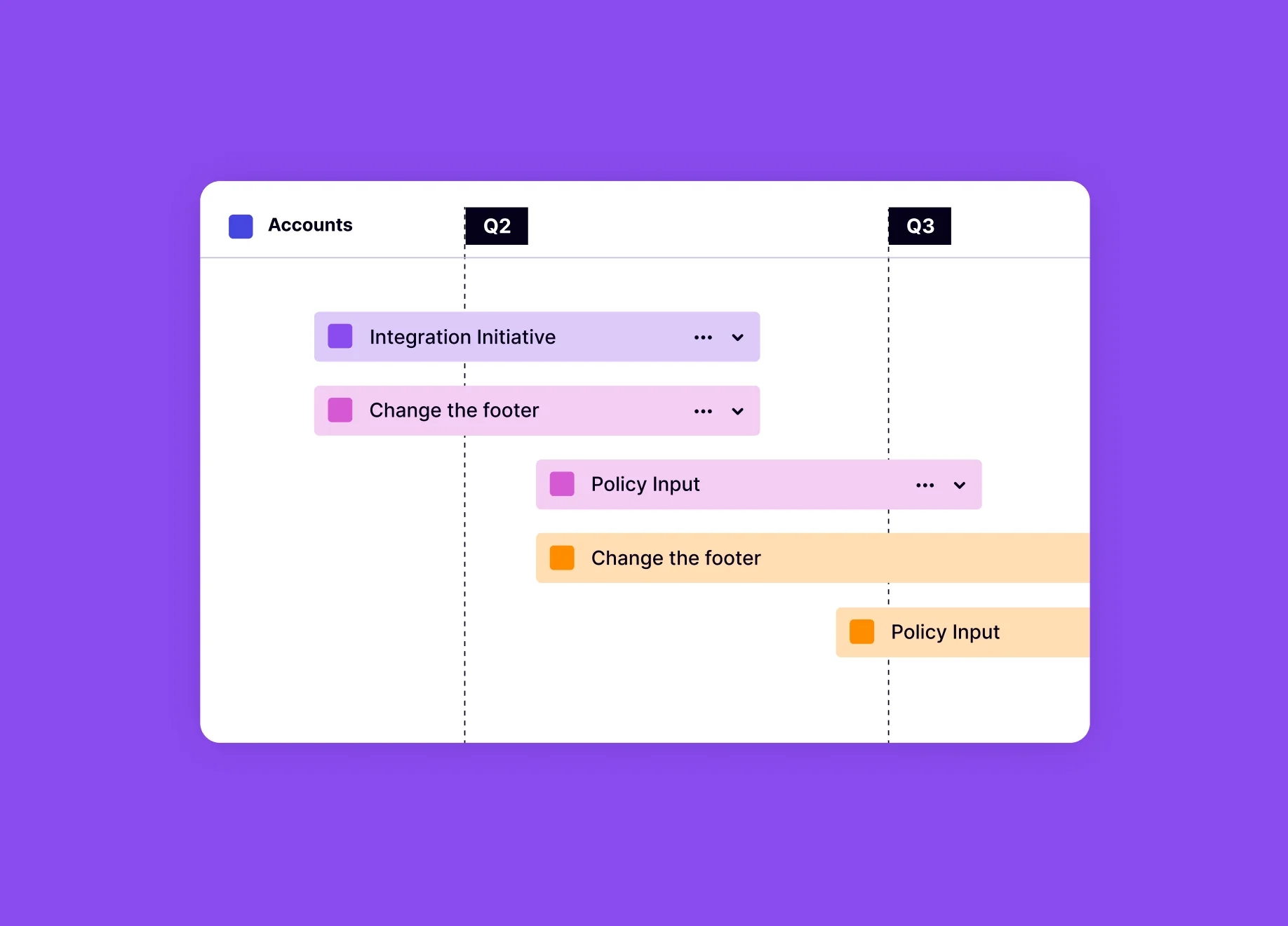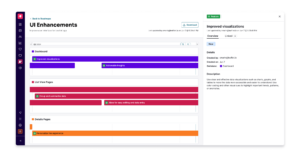
包括的ガイド
プロダクトロードマップ
顧客、見込み客、パートナー、内部関係者とのコミュニケーションを促進するための、プロダクトの方向性についての視覚的な概要。
さらに深く掘り下げる
目次
プロダクトロードマップとは何ですか?
プロダクトロードマップは、顧客、見込み客、パートナー、内部関係者とのコミュニケーションを促進するための、プロダクトの方向性についての視覚的な概要です。
ロードマップは、ユーザー調査や関係者のフィードバックに基づき、プロダクトの目指す方向性や主要なフィーチャー、および将来的な取り組みの概要を示すものです。
For product-led organizations, a product roadmap’s primary purpose is to define, communicate, and guide the direction that product development will take in the foreseeable future—facilitating the success of said development efforts to deliver on the expectations of all interested parties. Where digital transformation via software products is concerned, such roadmaps apply equally to software developed for internal use or sale to external consumers.
プロダクトロードマップドキュメントは、プロダクトのビジョン、意図する方向性、優先順位を長期的にマッピングし、ガイドするものです。
ロードマップを作成することで、すべてのチームがプロダクト目標に向けて足並みを揃え、関係者に計画を効果的に伝え、ユーザーに最大の価値をもたらすフィーチャーを優先することができます。よく練られたプロダクトロードマップは、最終的に、プロダクト開発への協力的で戦略的なアプローチを促進し、より良好な結果につながります。
プロダクトロードマップはどのように使われるのですか?
Rather than a statement of commitment or a detailed “contract,” a product roadmap signals general product direction as currently intended and understood, yet it must be able to shift with changes in market and business conditions. In this spirit, product-led organizations should see a product roadmap as a living document, a snapshot in time that is subject to frequent change. The more distant the time horizon, the less reliable the commitments.
たとえば、3か月先のロードマップ項目であれば比較的コミットメントに近いかもしれませんが、6か月、9か月、12か月の範囲では徐々に信頼性が低くなります。同様に、ロードマップで提供される詳細レベルは、期間が長くなるにつれて低下します。早い時期(現在に近い時期)ほど、ロードマップのフィーチャーや機能が具体的です。対照的に、後の範囲(さらなる将来)では、これから起こることを広いテーマで概観することができます。
プロダクトロードマップはプロジェクト計画とどう違うのですか?
どちらもプロダクト開発には欠かせないツールですが、プロダクトロードマップとプロジェクト計画は、その目的も、詳細のレベルも異なります。プロダクトロードマップは、細部にとらわれることなく、プロダクトの全体的なビジョンと戦略的テーマに焦点を当てた概要的な視点を取ります。
プロダクトロードマップ
プロダクトロードマップは、プロダクトの方向性と戦略的テーマの全体像を示すものです。将来の開発の「対象」と「理由」に焦点を当て、長期的な目標や取り組みを概説します。プロダクトジャーニーを導く羅針盤のようなものだと考えてください。
- Focus: Vision and themes
- Detail: Broader
- Timeline: Long-term
- Audience: Wider – internal & external
プロジェクト計画
一方、プロジェクト計画は、ロードマップの中で1つのプロジェクトを実行する際の具体的な詳細に焦点を当てます。特定の目標を達成するための「方法」を定義するもので、完了に必要なタスク、タイムライン、リソース、依存関係が概説されています。ロードマップの国にある特定の都市の詳細地図のようなものです。
- Focus: Task execution
- Detail: Highly detailed
- Timeline: Short-term for specific features
- Audience: Internal – project team
プロダクトロードマップは通常、概要的なものですが、オーディエンスによって提示する詳細度を調整することができます。たとえば、顧客には全体的なビジョンを示す簡略化されたロードマップを提示する一方で、社内チームにはより具体的なものを提示したい場合があります。
プロダクトロードマップがプロダクト開発の成功に不可欠なのはなぜでしょうか?
Product roadmaps serve as a foundational element for successful product development. A well-defined roadmap provides strategic direction, ensures clear communication across teams, and promotes alignment around product goals—all critical for effective change management. A well-defined roadmap fosters a strategic approach to building a product that delivers value to users and achieves business objectives.
Strategic direction: Like a compass, product roadmaps define the product’s overall vision and establish a clear path for achieving long-term goals. This definition ensures everyone aligns on the product’s direction and working towards the same objectives (such as delivering an exceptional user experience).
Clear communication and collaboration: The roadmap acts as a central communication hub, fostering transparency and understanding across all teams. Everyone has a shared sense of product priorities, upcoming features, and timelines, eliminating confusion and promoting a collaborative approach to development.
Alignment around product goals: By visualizing features and initiatives on the roadmap, you can make informed decisions about what to build first. Using a prioritization framework will help you focus development on features that deliver the most value to users and the business while de-prioritizing less critical ones.
プロダクトロードマップのコア(主要)となる機能とは?
プロダクトロードマップは、プロダクトジャーニーを導く羅針盤のようなものだと考えてください。これで、プロダクトの全体的なビジョンが定義され、主要なフィーチャーと取り組みの概要が示され、開発のタイムラインが決まります。ロードマップには、次のいくつかの重要な機能があります。
コミュニケーション
ロードマップは信頼できる中心的な情報源として機能し、以下を共有することで、チーム(プロダクト、開発、マーケティングなど)間の明確なコミュニケーションを促進します。
- Product vision: Everyone knows and can align on the long-term direction and goals of the product.
- Feature priorities: Teams understand which features are most important to focus on at different stages.
- Initiative timelines: Different departments can plan their work based on the roadmap’s timeline for upcoming features and initiatives.
計画
ロードマップは、戦略的目標とユーザーのニーズに基づいてフィーチャーを計画し、優先順位を付けるのに役立ちます。たとえば、ロードマップを使って次のようなことを実施できます。
- Align with business goals: Ensure features contribute to achieving the overall business objectives.
- Address user pain points: Prioritize features based on user feedback and data gathered through tools like Pendo Listen.
- Plan resources: Allocate resources effectively based on the roadmap’s prioritized features and timelines.
優先順位付け
ロードマップを可視化することで、何を最初に開発し、何を待つべきかについて、情報に基づいた決定を下すことができ、次のことが可能になります。
- Focus on high-impact features: Prioritize features that deliver the most value to users and the business.
- Manage dependencies: Identify dependencies between features and plan development accordingly.
- Adapt to change: Be flexible and adjust priorities to reflect market shifts or user expectations and feedback.
プロダクトロードマップを使用するのは誰ですか?
Product roadmaps are valuable tools for teams and stakeholders involved in the product development lifecycle both inside and outside the enterprise.
Product managers: Product managers rely on the roadmap to define the product vision, prioritize features based on user needs and strategic objectives, and communicate progress to internal and external stakeholders.
Developers: The roadmap provides insight into upcoming features and dependencies between them, allowing development teams to plan better, allocate resources effectively, and anticipate and address potential challenges.
Designers: Understanding the product vision and feature priorities outlined in the roadmap helps designers make informed design decisions that align with the overall product strategy.
Marketers: Marketers can use the roadmap to align marketing campaigns with upcoming product initiatives to create more targeted messaging and plan product launches effectively.
Executives: Executives gain a high-level view of the product’s direction and future through the roadmap to help them assess the product’s alignment with business goals and make strategic decisions.
External parties: Product roadmaps aren’t solely for internal use. Business partners, resellers, and customers benefit from knowing “what’s coming up.” This transparency allows partners to prepare their teams (developers, sales, marketing) for upcoming product changes. It also helps customers anticipate how upcoming changes might impact their users and internal processes, allowing them to plan their migration strategy and ensure a smooth transition.
プロダクトロードマップの2つのタイプとは?
プロダクトロードマップには大きく分けて2つのタイプがあり、それぞれに明確な目的があります。
Internal roadmaps (detailed for team communication): Internal roadmaps are typically more granular, outlining specific features, user stories, and development timelines. They are intended for internal use by development teams and product managers. Subtypes of internal roadmaps can include development roadmaps focusing on technical initiatives or marketing roadmaps detailing marketing campaigns aligned with product launches.
External roadmaps (high-level, for customer communication): Shared with customers and the public, external roadmaps provide a broader view of the product’s future direction and the benefits of upcoming features. They should avoid specific deadlines or feature details, focusing on the overall product vision.
プロダクトロードマップには何を含めるべきですか?
プロダクトロードマップは、社内外の関係者にプロダクトの将来に関する包括的な概要を提供する必要があります。ここでは、考慮すべき次の4つの重要な要素を紹介します。
- Goals and objectives: Clearly define your overarching product goals and objectives. Aligning these goals with user needs identified through Voice of the Customer (VoC) research ensures you’re building features that truly address user pain points.
- Initiatives and themes: Break down your product goals into larger initiatives or themes. These initiatives should be informed by product discovery using tools like Pendo Listen. Pendo Listen captures and analyzes user feedback to identifies opportunities of improvement. By understanding user behavior and feedback, you can ensure your initiatives target the right areas for improvement.
- Features and epics: For internal roadmaps, further break down initiatives into specific features or epics (large user stories) that deliver user value.
- Timeline: Establish a timeline for your roadmap. While specific dates can be helpful for internal planning, consider using ranges or milestones for external communication to maintain flexibility and adapt to changing circumstances.
プロダクトロードマップを作成する際に避けるべきよくある間違いとは?
どんなに良い意図があっても、的外れなロードマップになることがあります。ここでは、プロダクトロードマップを作成する際のよくある間違いと、それを避ける方法を紹介します。
- Treating it as a feature list: Your roadmap shouldn’t be a laundry list of every desired feature. Focus on the “why” behind features, outlining the goals and user problems they aim to solve.
- Lack of user focus: Don’t build in a vacuum! Make sure your roadmap reflects user needs and priorities. Gather user feedback through tools like Pendo Listen to understand users’ pain points.
- Unrealistic timelines: Setting overly ambitious deadlines can lead to frustration and missed expectations. Be realistic about the time and resources needed to develop features.
- Inflexibility: The software landscape is constantly evolving. Avoid creating a rigid roadmap that can’t adapt to changing market conditions, user feedback, or new opportunities.
- Poor communication: A roadmap is only valuable if everyone understands it. Regularly communicate updates to keep all stakeholders aligned, using visuals and avoiding excessive jargon to keep everything clear.
- Neglecting dependencies: Not considering dependencies between features (or other project initiatives) can lead to development road blocks. Identify and plan for dependencies to ensure a smooth development process.
- Ignoring stakeholder input: While end-user focus is crucial, don’t neglect input from internal or partner sources. Consider the needs of different stakeholders like sales and marketing teams but prioritize based on user needs and business goals.
- Lack of prioritization: Giving all features equal priority leads to a scattered development effort. Apply user analytics, Voice of the Customer data, and feature prioritization frameworks to focus on features that deliver the most value.
- Overlooking the big picture: Don’t get bogged down in too much detail. Maintain a focus on the overall product vision and strategic direction while outlining your roadmap.
このようなよくある間違いを意識することで、明確で、実行可能で、プロダクトを成功に導くプロダクトロードマップを作成できます。
お客様の声(VOC)のデータを使用して、ロードマップ項目に優先順位を付けるにはどうすればよいですか?
Prioritizing your product roadmap by leveraging Voice of the Customer (VoC) data is crucial for focusing on features that deliver the most value to users. Various tools and techniques can help guide your decision-making, including the following:
Prioritization frameworks like MoSCow (Must-Have, Should-Have, Could-Have, Won’t-Have) or RICE (Reach, Impact, Confidence, Effort) can help you evaluate roadmap items. These frameworks weigh factors like user value, development effort, and business impact.
Tools to collect and analyze VoC Data can play a critical role in prioritizing roadmap items. For example, Pendo Listen can gather and analyze VoC data with features like user feedback surveys, session recordings, and heatmaps, providing you with valuable insights into user needs, pain points, and feature requests. Integrating VoC data into your prioritization process ensures you build features that directly address user problems.
Balancing short-term wins with long-term vision is critical. While addressing immediate user needs, you must keep your long-term product vision in mind. Consider prioritizing a mix of short-term wins (e.g., bug fixes) that improve user experience and more significant features that align with your long-term goals as informed by VoC insights.
プロダクトの発見は、どのようにロードマップ開発に反映されるのでしょうか?
Product discovery is a crucial step before building features. It involves understanding user needs and pain points to ensure you’re developing features that solve real problems. Here’s how product discovery informs roadmap development:
Understanding user needs: Before building anything, you must understand what your users actually need. Pendo Listen empowers product discovery by facilitating user research, analyzing usage patterns, and identifying areas for improvement. Uncovering behavior patterns and pain points lets you to craft a roadmap flush with features that directly address users’ actual wants and needs.
プロダクトロードマップを最新の状態に保つには?
健全なプロダクト環境は常に進化しています。次の提案に従って、プロダクトロードマップを現状に合った最新で関連性のある状態に保ってください。
Regular reviews: Schedule periodic reviews of your roadmap (e.g., quarterly) to reflect changes in the market, user feedback, and business goals.
Adapting based on learnings: As you gather new data and insights from user feedback and product usage data by leveraging tools like Pendo Listen, don’t be afraid to adjust priorities or timelines accordingly.
Maintaining flexibility: Over the life of any software product, unforeseen circumstances can (and will) arise. Your product roadmap must be flexible to accommodate these situations and ensure you and your product are agile enough to respond quickly to change.
明確で効果的なプロダクトロードマップを作成するためのベストプラクティスとは?
よく練られたプロダクトロードマップは理解しやすく、全員の足並みが揃い、状況の変化に適応します。ここでは、従うべき4つのベストプラクティスを紹介します。
- Clarity and simplicity: Keep your roadmap clear and concise. Use visuals and avoid excessive jargon to ensure everyone can understand the roadmap’s key points.
- Focus on the big picture: While outlining key milestones, prioritize the overall product vision and strategic direction over excessive detail.
- Embrace flexibility and adaptability: The product landscape is dynamic. Be prepared to adapt your roadmap based on new learnings or changing priorities.
- Consistent (and continuous) communication: Effectively communicate roadmap updates with all stakeholders. This transparency fosters buy-in and keeps everyone on the same page.
企業はプロダクトロードマップをどのように管理していますか?
There are lots of commercial tools for creating and managing product roadmaps. Pendo provides some capabilities in this area, as do vendors, including Aha!, ProdPad, ProductBoard, ProductPlan, and others.
Many companies still create and manage product roadmaps using general-purpose tools like PowerPoint and Confluence, but often find this to become unwieldy as the documents are updated over time and adapted for different audiences. Black Diamond, for example, used Pendo Feedback to completely redesign their road-mapping and customer feedback collection process, doing away with antiquated spreadsheets and adding a layer of automation.
プロダクトロードマップツールには何を求めるべきでしょうか?
プロダクトロードマップツールは、ロードマップの管理と視覚化に多くの利点があります。ロードマップの作成や管理において可能な限り最高の体験を提供するために、次のようなものが提供されるはずです。
Improved organization and visualization capabilities: Roadmap tools should provide a dedicated space to organize your roadmap information, making it easier to visualize timelines, dependencies, and feature details.
Collaboration features: Your roadmap tools should offer features that facilitate team collaboration, allowing for real-time updates and discussions around the roadmap.
Integration with tools that complement roadmap management: Consider using a roadmap tool that integrates simply and directly with product experience platforms to provide product discovery, user feedback, product adoption, and other essential capabilities that Pendo provides. Your roadmap tool should allow you to connect VoC data and usage analytics (such as those available via Pendo Listen) directly to your roadmap, informing your product decision-making and prioritizing features based on user needs.
プロダクトロードマップを作成し、軌道に乗せるために、Pendoはどのように役立ちますか?
Pendoリッスンは、ユーザーリサーチの実施、使用パターンの分析、ユーザーフィードバックやセッションリプレイなどのフィーチャーによって機会の特定を行うツールを通じて、より良いプロダクトの発見を支援します。Pendoリッスンを通じて明らかになったユーザーのニーズを取り入れることで、ユーザーにとって本当に重要なものをロードマップに反映させることができます。
- AI-powered feedback analysis: Pendo Listen gathers valuable VoC data to help prioritize what goes into your roadmap. Prioritize features that deliver the most value and address critical user needs.
- Promote ideas to roadmaps: Pendo Listen integrates your roadmaps and feedback data so you can push promising ideas directly into your product roadmaps, and easily add user-driven insights into your planning. You can choose to add these promoted ideas as individual features or group them into initiatives.
- Integrate with other tools: Connect VoC data from your CRM, .CSV files, and product usage into Listen for data-driven decision-making. Visualize user behavior and feature impact alongside your roadmap to inform prioritization and ensure your roadmap reflects real user needs.
Pendoの一連のツールとベストプラクティスを活用することで、プロダクトを長期的な成功へと導くプロダクトロードマップを作成できます。





